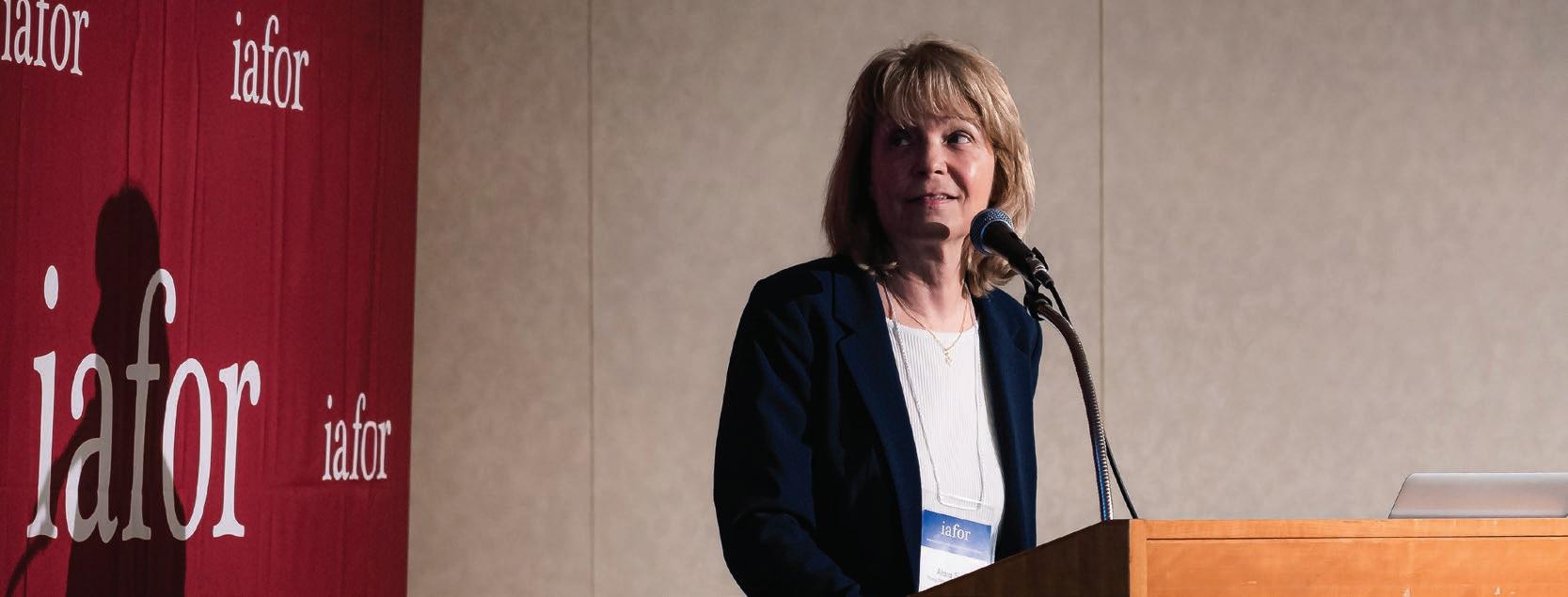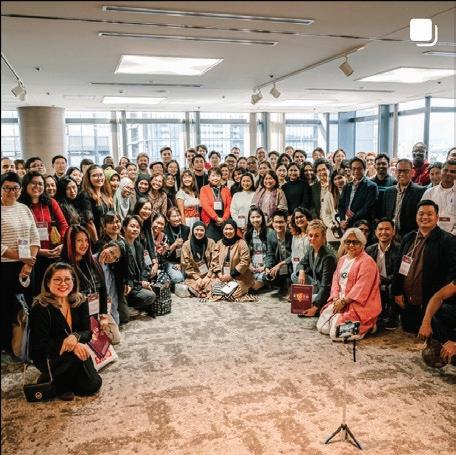
IAFOR UNDERGRADUATE RESEARCH SYMPOSIUM (IURS)
HANDBOOK




Welcome to the IAFOR Undergraduate Research Symposium (IURS).
This two-day IURS programme gives participants the opportunity to enhance their presentation and oral communication skills through an online seminar and an onsite presentation. This international, intercultural, and interdisciplinary course offers a wonderful opportunity for undergraduate students to join their academically engaged peers in presenting their research project to a group of keen and like-minded delegates, academics, and professionals. Learn from their feedback and advice, and in turn, develop your presentation skills, broaden your professional network, and forge new friendships.
Participants must join the full two-day programme.
Day 1 is held online and focuses on the preparation step of your final Poster Presentation: how to formulate your thoughts and structure your presentations in ways that are engaging and easy to understand, and communicate your intentions with maximum clarity and impact. You will not be presenting on this day.
Day 2 is held onsite during an IAFOR Conference. Day 2 focuses on the hard skills that allow you to operate as an effective communicator during presentations. These techniques are invaluable in academic, business and everyday contexts, and will allow you to convey your ideas in ways that will leave strong impressions on your audience. Your presentation will be on this day.
Participants will receive a digital Certificate of Presentation from IAFOR after the Symposium concludes.
Language Requirement: The symposium will be conducted in English.
Participants should have an Intermediate to Advanced EFL/ ESL proficiency level.
– The IURS Organising Committee

An abstract is a short summary of your research that is between 100 to 250 words long. The purpose of an abstract is to inform the reader of your research in order for them to determine whether they would like to know more about it. Please see below for the recommended structure for how to write an abstract.
1. Introduction
• Briefly introduce your research
• Define the purpose of your study
• Include any context or background information that you believe to be important
2. Methods
• Describe the research methods used
3. Results
• Include your main results or findings
4. Discussion
• Discuss the main conclusions of your research
A Poster Presentation is a more casual way of presenting your research as it allows presenters to give a quick overview of their work, tailoring the focus to the individual or small audience. It is a more conversational way of presenting and is particularly popular across disciplines where research is datadriven.
1. Submit your abstract
All submitted abstracts will be subjected to a blind peer-review process. A decision to accept or reject a submission for presentation will be based solely on the quality of the submitted work.
2. Register for the Conference
If your submission is accepted for presentation at the conference, please confirm your attendance by registering as a Poster Presenter from the conference website. Your attendance will be confirmed after the payment of registration fee.
3. Join Day 1 online
This online training aims for the participants to learn the techniques needed to create and present your Poster Presentation with the IURS Facilitators.
4. Join Day 2 onsite
This onsite activity serves as a platform for you to present your poster and your research in front of tenured researchers who will be able to give you detailed feedback. This is the opportunity to exercise and incorporate the techniques learned from Day 1 and adapt them to fit your personal style.
5. Embrace your achievement
A Certificate of Presentation will be sent to you in PDF format as a token to remind you of your achievement, and encourage you to further advance your path in academia.

Poster presentations allow you the freedom present your research in a range of styles.
Poster presentations allow delegates to interact with one another, helping to build connections. You may end up meeting someone who you could potentially work with in the future.
Provides the opportunity to receive feedback about your research, as well as insight into different areas of your field of research. This will allow you to further improve your work, and moreover, potentially inspire you.
Since you are not under a time constraint, you are allowed more freedom and flexibility with how you present your research. This will allow you the chance to have in-depth conversations regarding your research.
If you are inexperienced with presenting, or struggle with presenting in front of an audience, this is the perfect way to practise. While you will still have to communicate and explain your research to others, you will have the opportunity - through trial and error - to learn about the best and most effective method to present your research.
The poster display boards are 900 mm wide x 1800 mm high. Tape and pins are available from the conference Registration Desk. It is recommended that poster presenters use thin, lightweight poster paper. Each board will have pushpins and adhesive tape available for presenters to secure their poster.
One of the most important things about a poster presentation is how visually appealing it is. You want the whole poster to look aesthetically pleasing, as the overall poster will be the first thing the delegates see.
Think of an interesting, eye-catching title that will grab your audience’s attention.
This will be one of the first things the delegates will read, therefore you want something that will either clearly communicate the main message of your topic or leave the delegate wanting to read more through hinting at an unexpected result or finding.
Underneath the title, state what your topic is about. You may want to include reasons as to what drew you to research the particular topic. Your introduction should be brief, we recommend no longer than a paragraph.
Describe how, when and where your research was conducted. You may want to use bullet points or flowcharts instead of large paragraphs to break down the process, so it is easier for the delegates to read.
You would want to keep this next to the introduction, either below or to the right hand side, for structural purposes. It is important that your poster has a clear structure, and the text is not randomly placed around. Following the standard layout of left to right, top to bottom will help the delegates be able to easily navigate your poster.
Take into consideration who your target audience is and what they would find interesting to read. You may want to use diagrams or images to help present your findings. Anything visual will help the delegates understand your research further.
This should be the biggest section on your poster. You may want to place this centrally.
Write a short summary of your findings. This should be brief and highlight the key points that you have previously discussed.
You may want to highlight or use bold formatting for the important findings.
If you have used any references in your poster, you will want to cite them. As well as references, you may want to acknowledge anyone who may have helped you with your project.

Drawing from the experiences of the facilitators who have been involved extensively in the symposium since its initiation in 2015, here are the Top Five Delivery Tips for an engaging, effective, and successful delivery of Poster Presentation.
Showing passion and enthusiasm about your topic is just as important as your research content and poster design. One way or another, in every presentation, you are expressing what you believe, who you are, and your deepest values.
Show your commitment to the topic. Your passion for your topic is what it is all about when giving a presentation.
Start out strong. Be confident in delivering your presentation. Give the audience a good first impression and the rest of the presentation will glide. Being confident gives you an image of being a true professional, adding value to your presentation and your research. Remember that everybody at the conference is there to support you, not to spot your mistakes. If there are overlooked mistakes, own it and improve it later.
Stay focused, stay on message, and keep each point short. You are making a short communication to the audience who can walk away to another Poster Presentation at any moment. Maximize your time by delivering your key message first. Audiences usually focus on the results rather than a long introduction. Telling them what you found out first is better than having them walk away in the middle of a long introduction, not having a chance to let them know what you have found.
Connect to your audience with good eye contact. Own your poster, but do not read from it. Use your poster as the communication tool between you and your audience. Maintaining eye contact with your audience helps engage them more than turning your back on them to read your poster. Reading straight from your poster can give the impression that you may not fully understand your topic. Engage with your audience and turn any possible glitch into a conversation.
Always remain gracious. Even if you have practised and are well-prepared, sometimes unexpected glitches happen. Do not panic. Remain calm and in control. If you forget the statistic, glance at your poster and read it to your audience. If you are nervous, take a deep breath, then breathe out. Your professional audience has been in your position before, so they will understand. Your fellow audience members are in the same situation as you are, and they are there to cheer you up.
Your audience looks at your poster and listens to your presentation because they are interested in what you have done and what you have to say. Give them what they are here for. Do what you are here for.

Learn more about the possible poster designs and contents from the previous Poster Presentations across disciplines from the following selected presentations:
“Why the Hate: The Recent Rise of Asian American Racism on Social Media”
The Asian Undergraduate Research Symposium (AURS10)
Yun Yeong Choi, University of Utah, United States
https://submit.iafor.org/submission/submission69646/
“Marriage of Convenience: The Symbiotic Relationship Between the Unification Church and Japan’s LDP”
The Asian Undergraduate Research Symposium (AURS10)
Matthew King, Emory University, United States
https://submit.iafor.org/submission/submission67731/
“Evaluation of Green City Implementation in the City of Bandung According to Assessment of the Asian Green City Index”
The Asian Undergraduate Research Symposium (AURS10)
Zalva Noer Salsabila, Indonesia University of Education, Indonesia
Ikrima Fatia Nurazizah, Indonesia University of Education, Indonesia
Ghina Nurhanifah, Indonesia University of Education, Indonesia
Aliya Ikhlasshafa Kirana, Indonesia University of Education, Indonesia
Lahfa Muhajirah, Indonesia University of Education, Indonesia
Ekklesia Praysca, Indonesia University of Education, Indonesia
https://submit.iafor.org/submission/submission69658/
“Development of Educational Board Games According to the Concept of Learning Management Through Games to Develop Health Education Learning Achievement”
The Asian Undergraduate Research Symposium (AURS10)
Sasiwimol Poolklay, Kasetsart University, Thailand
Wichanon Poonsri, Kasetsart University, Thailand
Sunee Kaewkham, Rachineeburana School, Thailand
Suppawan Vongsrangsap, Kasetsart University, Thailand
https://submit.iafor.org/submission/submission67719/
The International Academic Forum (IAFOR)
Sakae 1-16-26 2F, Naka-ku, Nagoya 460-0008 Japan
IAFOR.ORG I FACEBOOK I TWITTER
Follow the International Academic Forum on lnstagram and join the conversation using the hashtag #IAFOR.

iafor.official






